Enyo lugubris lugubris
|
|
Updated as per
AN ANNOTATED CHECKLIST OF THE SPHINGIDAE OF BOLIVIA, October 2007
Updated as per http://www.pybio.org/MACROGLOSSINAE.htm (Paraguay), October 2007
Updated as per More, Kitching and Cocucci's Hawkmoths of Argentina 2005, October, 2007
Updated as per personal communication with Ezequiel Osvaldo Núñez Bustos (Argentina), Ocotber 2007
Updated as per personal communication with Vladimir Izersky (January-February, Coviriali, Junin, Peru, 662m), December 2008
Updated as per Sphingidae (Lepidoptera) de Venezuela, Compilado por: María Esperanza Chacín; December 2009
Updated as per personal communication with Larry valentine (Itanhandu, souther Minas Gerais, Brazil, January 25, 2010); January 2010
Updated as per French Guiana Systematics; April 12, 2011
Updated as per personal communication with Dirk Bayer (larvae: Bon Secour, Alabama, September 4, 2012, October 1, 2010); September 4, 2012
Updated as per personal communication with Jeff Trahan (Shreveport, Caddo Parish, Louisiana, October 10, 2012); January 15, 2013
Updated as per "A Hawk Moths fauna of southern Maranhão state, Brazil, ... "; NEVA: Jahrgang 34 Heft 3 November 2013; via Jean Haxaire; April 5, 2014
Updated as per personal communication with Sergio D. Ríos Díaz in CATÁLOGO DE LOS SPHINGIDAE (INSECTA: LEPIDOPTERA) DEPOSITADOS EN
EL MUSEO NACIONAL DE HISTORIA NATURAL DEL PARAGUAY; sent to me in July 2014 by Sergio D. Ríos Díaz.
Updated as per personal communication with Tony James (male: 73mm, Radisson, Panama, Panama, April 19, 2015); May 6 2015
Updated as per personal communication with Ezequiel Bustos (Shilap revta. lepid. 43 (172) diciembre, 2015, 615-631 eISSN 2340-4078 ISSN 0300-5267), January 4, 2016
Updated as per personal communication with Jean Haxaire, (La Vega, Dominican Republic); March 13, 2017
Updated as per personal communication with Juliette Robb, (Montgomery County, Texas); October 10, 2018
Updated as per personal communication with Francierlem Oliveira, (Extremoz, Rio Grande do Norte, Brazil, November 11, 2018); May 22, 2019
Updated to include Enyo lugubris, August 25, 2021, Tom Middaugh, Worthington, Nobles County; September 7, 2021
|
Enyo lugubris lugubris
EN-yohMLEW-goo-brisMLEW-goo-bris
Mournful Sphinx Moth
(Linnaeus, 1771) Sphinx
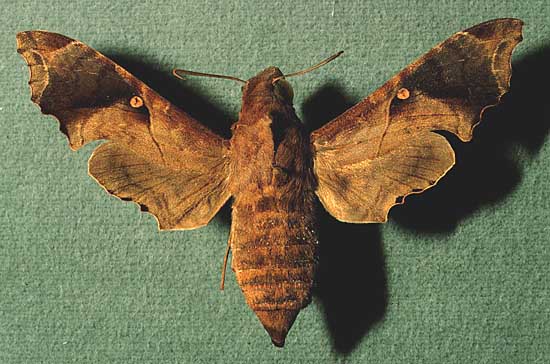
Enyo lugubris lugubris female courtesy of Dan Janzen.
This site has been created by Bill Oehlke.
Comments, suggestions and/or additional information are welcomed by Bill.
TAXONOMY:
Family: Sphingidae, Latreille, 1802
Subfamily: Macroglossinae, Harris, 1839
Tribe: Dilophonotini, Burmeister, 1878
Genus: Enyo Hubner, [1819] ...........
Species: lugubris lugubris (Linnaeus, 1771)
|
MIDI MUSIC
.....It's a Wonderful World.....
copyright C. Odenkirk
ON.OFF
<bgsound src="world.mid" LOOP=FOREVER>
|
DISTRIBUTION:
The Mournful Sphinx Moth, Enyo lugubris lugubris (Wing span: 2 - 2 3/8 inches (5 - 6 cm)), flies in
Argentina: Buenos Aires, Chaco, Corrientes, Entre Rios, Formosa, La Rioja, Misiones, Salta, Santa Fe, Tucuman; and
Paraguay: Alto Paraguay, Boqueron,
Presidente Hayes, Concepcion, Amambay, (probably San Pedro (WO?)),
Canindeyu, Alto Parana, Cordillera, Central, Caaguazu, Guaira,
Paraguari, (probably Caazapa, Itapua, Misiones, Neembucu (WO??):
Uruguay;
Venezuela: Apure, Aragua, Bolivar,
Guarico, Lara, Portuguesa;
Guyana: Morawhanna;
Surinam;
French Guiana: Kaw;
Colombia;
Ecuador;
Peru: Junin;
Paraguay: Asuncion; Central; Canindeyu;
Brazil: Minas Gerais (LV), probably Rio de Janeiro and Sao Paulo and most of Brazil; southern Maranhao; Ceara;
the West
Indies, and
Mexico;
Belize: Corozol, Orange Walk, Cayo, Toledo;
Guatemala;
Honduras;
El Salvador;
Nicaragua;
Costa Rica; and
Panama: Panama: Radisson; Gamboa at elevations from sea level to at least 2700m.
It would also be found in most, if not all, of the Carribean Islands. Jean Haxaire provides a beautiful image of
Enyo lugubris from the Dominican Republic.
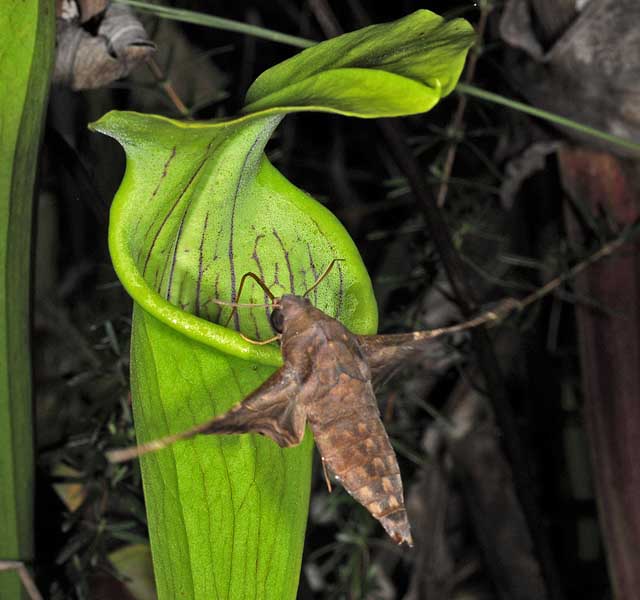
Enyo lugubris nectaring at Sarracenia alata, October 17, 2008, 50m,
Sabine National Forest, Jasper County, Texas, courtesy of Wolfgang Stuppy.
Visit Enyo lugubris nectaring at Sarracenia alata, October 17, 2008, 50m,
Sabine National Forest, Jasper County, Texas, courtesy of Wolfgang Stuppy.
In the United States
the moth has been taken from Arizona east to Florida and north to
South Carolina. Strays sometimes appear in Arkansas and as far north as Illinois,
Michigan and New York. Tom Middaugh sends an image of a stray into bait trap, Worthington, Nobles County, Minnesota.
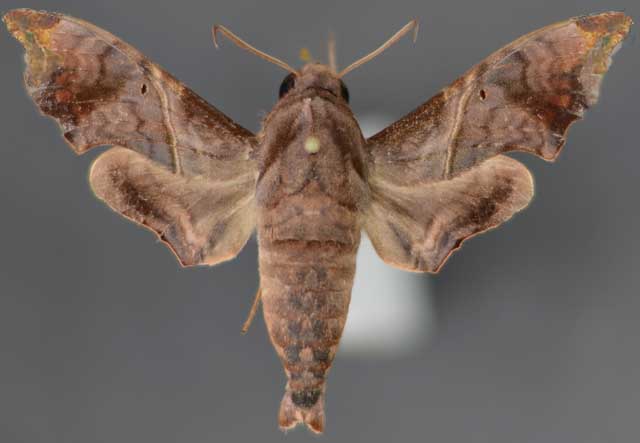
Enyo lugubris stray, Worthington, Nobles County, Minnesota,
August 25, 2021, courtesy of Tom Middaugh, digital repair to fw apices & upper o.m. by Bill Oehlke.
Antigua is the specimen type locality.
Visit Stepanie Sanchez's
Enyo lugubris images from southern Florida.
Visit Enyo lugubris, Wauchula, Hardee County, Florida, August 30, 2013, Greg Roehm.
Visit Enyo lugubris, Islamorada, Monroe Co., Florida, December 22, 2008, Shelby Heeter.
Visit Enyo lugubris, Shreveport, Caddo Parish, Louisiana, October 10, 2012, Jeff Trahan.
Visit Enyo lugubris, Coral Gables, Miami-Dade County, Florida, October 29, 2011, 7:00 pm, Jorge Crespo.
Visit Enyo lugubris, Hinesville, Liberty Co., Georgia, Nicole Janke.
Visit Enyo lugubris, male and female, Panama, April, 2015, Tony James.
Visit Enyo lugubris, Macico do Baturite, Aratuba, Ceara, May 12,
2016, courtesy of Meremii Souza.
Visit Enyo lugubris, Extremoz, Rio Grande do Norte, Brazil, November 11, 2018,
courtesy of Francierlem Oliveira.
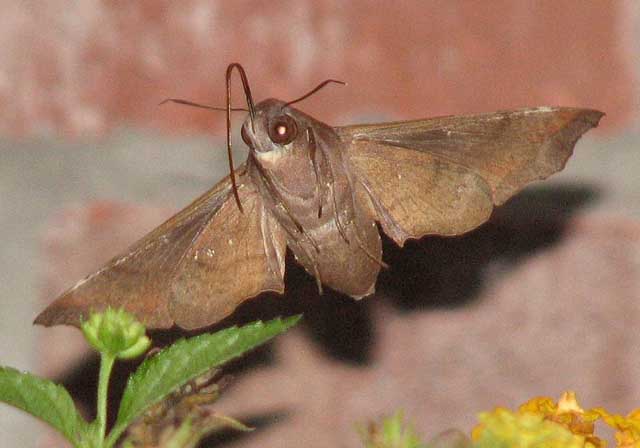
Enyo lugubris lugubris, Tyler, Smith County,
northeastern Texas,
November 7, 2007, courtesy of Justin & Valerie Valleau.
In Bolivia, the species has been recorded in "Santa Cruz: Andrés
Ibáñez; Ichilo, El Chore; Florida, Pampa Grande; La Paz: Murillo,
Zongo Cuticucho; Cota Cota; Beni: José Ballivián, Estación Biológica
del Beni; La Paz: Murillo, La Paz; Larecaja, San Agustín, Mapiri,
3500'; Santa Cruz: Sarah, 450m; German Bush, Puerto Suárez, 150m;
"Cuatro ojos"; Andrés Ibáñez, Santa Cruz; Beni: "Lower Mamoré"."
Haxaire
Visit Enyo lugubris, male and female, live and spread, Coviriali, Junin, Peru,
662m, January 10 and February 9, 2008, courtesy of Vladimir Izersky.
The body and wings are dark brown. The forewing has a large black patch
covering most of the outer half of the
wing. There is a pale tan cell spot (dark inner pupil), and a fairly
straight median line to the inside of the cell spot.
Sphinx fegeus Cramer, 1780, Surinam, is same as
Enyo lugubris lugubris.
Epistor luctuosa Boisduval, [1875], Brazil, is same as Enyo lugubris lugubris.
ab. Epistor rufa Silva, 1934, Brazil, is same as
Enyo lugubris lugubris. Enyo lugubris lugubris,
Yasuni, Ecuador, September 10, 2002 - 10:28 PM, courtesy of
Steve Graser. | 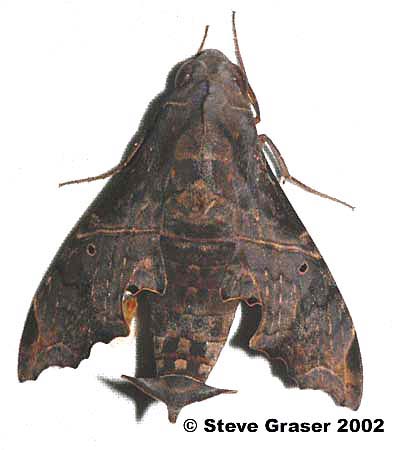
|
Visit Enyo lugubris,
Misiones, Argentina.
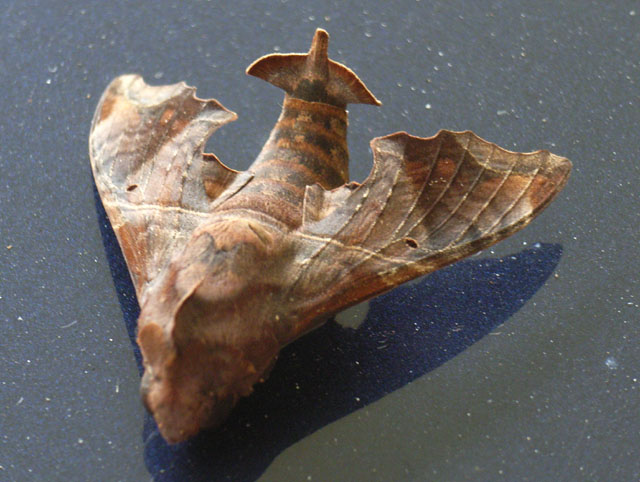
Enyo lugubris, Anna Maria Island, Florida, November 20, 2006,
courtesy of Juergen Lachmann.
FLIGHT TIMES:
Enyo lugubris lugubris broods
continuously in the tropics, south Florida, and Louisiana. Moths
are on the wing from August-November in more northern locales.
In Bolivia there are records for January, March, and June-December.
Vladimir Izersky reports them on the wing in January-February in Peru.
Larry Valentine reports a January flight in Itanhandu, Minas Gerais, Brazil. Visit
Enyo lugubris recto and verso, Itanhandu, Minas Gerais, Brazil, January 25, 2010.
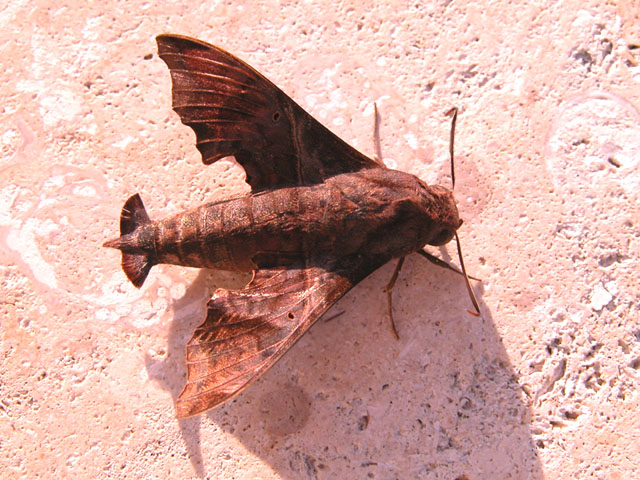
Enyo lugubris, Miami Dade County, Florida, December 10, 2004,
courtesy of Lisa D. Anness.
Visit Enyo lugubris
adult, October 20, 2007,
Grey Forest, Texas,
courtesy of Mike van Buskirk.
ECLOSION:
Adults eclose from pupae formed in loose cocoons in shallow underground burrows.
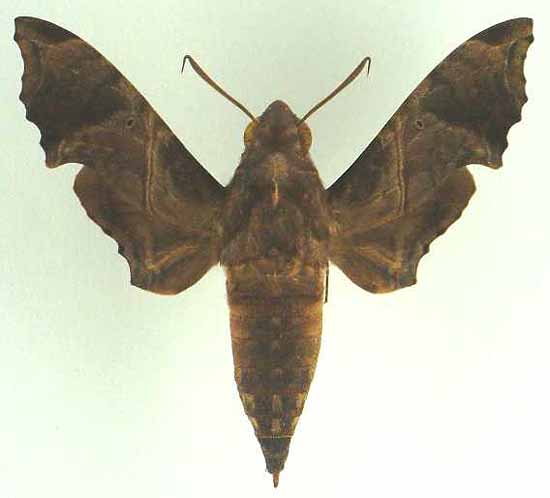
Enyo lugubris lugubris male (dark phase) courtesy of Vernon Brou.
SCENTING AND MATING:
Females call in the males with a pheromone released from a gland at the tip of the
abdomen. Both males and females nectar at flowers during the day, making a strong whirring sound as
they hover. In Florida they have been reported hovering over flowers of Asystasia gangetica
at dusk.
EGGS, LARVAE, PUPAE:
Larvae show several colour variations. Visit Enyo lugubris: three different
larval colour forms, Long Beach, Harrison County, Mississippi, courtesy of Ashley Geil.
Moths can emerge from pupae in as few as seventeen days, maybe less! Ignez de Castro in Jundiai, Sao Paulo, Brazil.
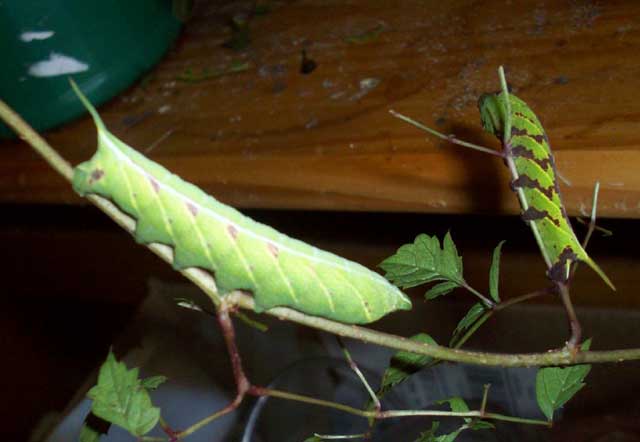
Enyo lugubris, larvae (different colour forms), Bon Secour, Alabama,
September 4, 2012, courtesy of Dirk Bayer.
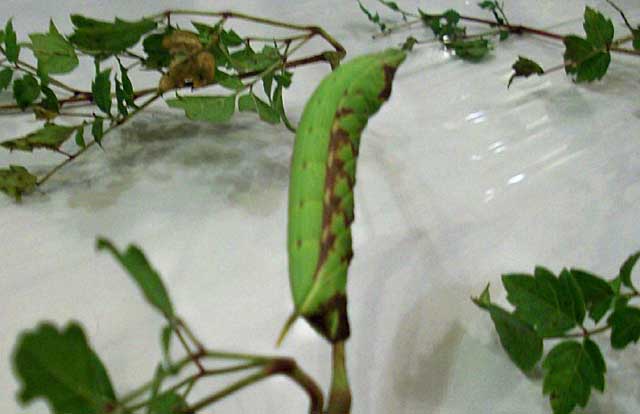
Enyo lugubris, larva, Bon Secour, Alabama,
September 4, 2012, courtesy of Dirk Bayer.
Larvae probably feed on Vitus tiliifolia
and other members of the
Vitaceae family: Vitis, Cissus, Ampelopsis.
In Florida larvae have been reported on larvae on Possum Vine (Cissus sicyoides) and Pepper
Vine (Ampelopsis arborea). The "horn" is very long in early instars and head is
relatively large. As the larva matures, the body develops rapidly, leaving the head relatively small and the "horn"
relatively short.
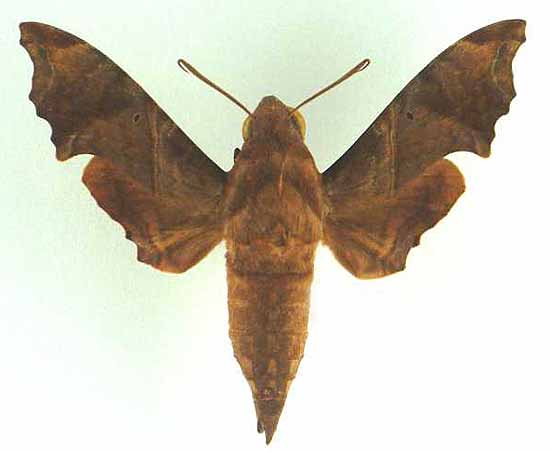
Enyo lugubris lugubris male (light phase) courtesy of Vernon Brou.
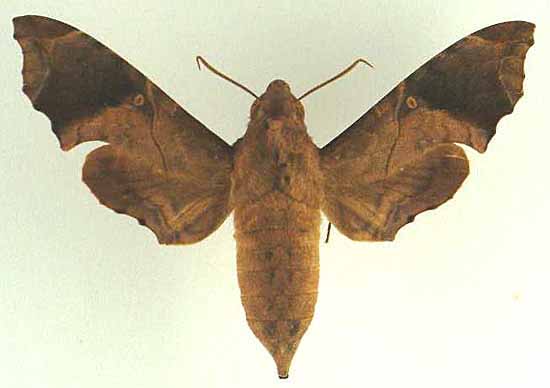
Enyo lugubris lugubris female (light phase) courtesy of Vernon Brou.
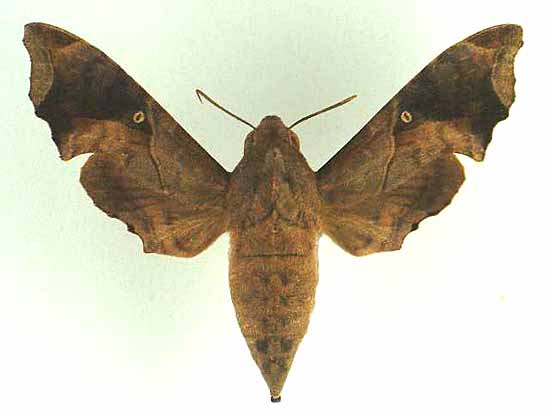
Enyo lugubris lugubris female (dark phase) courtesy of Vernon Brou.
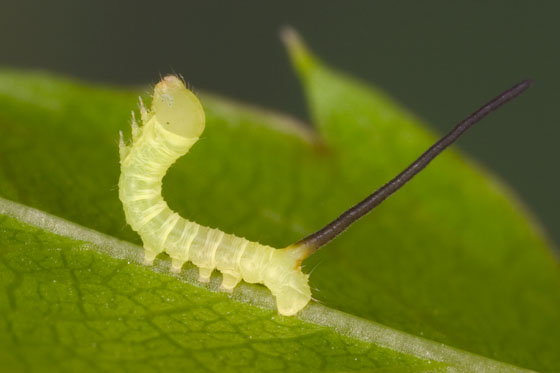
Enyo lugubris, first instar, Boca Raton, Florida, courtesy
of Alan Chin-Lee.
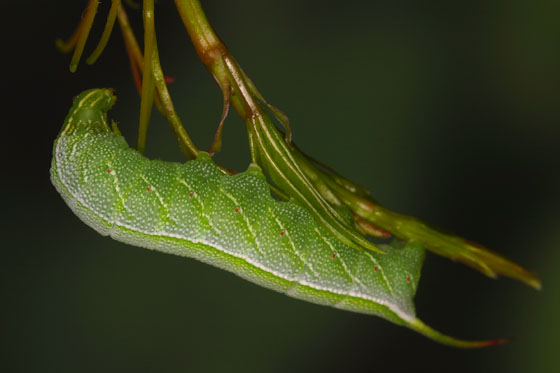
Enyo lugubris, fourth instar, Boca Raton, Florida, courtesy
of Alan Chin-Lee.
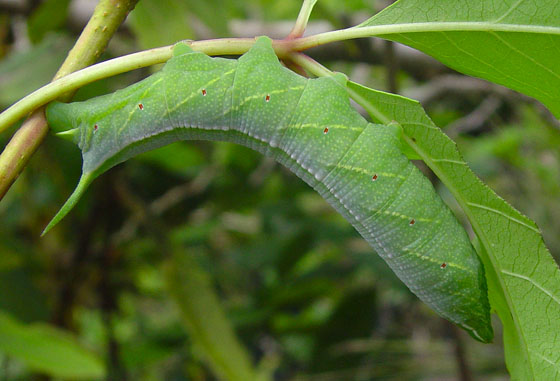
Enyo lugubris, fifth instar, Boca Raton, Florida, courtesy
of Alan Chin-Lee.
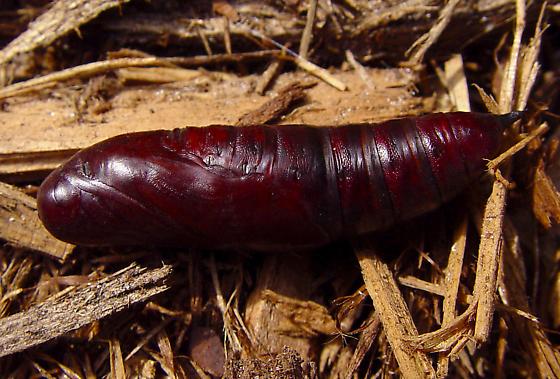
Enyo lugubris, pupa, Boca Raton, Florida, courtesy
of Alan Chin-Lee.
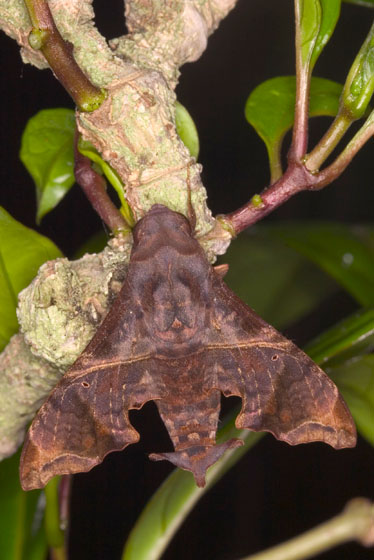
Enyo lugubris, Boca Raton, Florida, courtesy
of Alan Chin-Lee.
Use your browser "Back" button to return to the previous page.
Return to U. S. A. Table
Return to Sphingidae Index
Return to Dilophonotini Tribe
Enjoy some of nature's wonderments, giant silk moth cocoons.
These cocoons are for sale winter and fall. Beautiful Saturniidae moths will emerge the following spring and summer.
Read Actias luna rearing article.
Additional online help available.
Eggs of many North American species are offered during the spring and summer. Occasionally
summer Actias luna and summer Antheraea polyphemus cocoons are available. Shipping to US destinations is done
from with in the US.
This page is brought to you by Bill Oehlke and the
WLSS. Pages are on space rented from Bizland. If you would like to become a "Patron of the Sphingidae Site", contact Bill.
Please send sightings/images to Bill. I will do my best to respond to requests for identification help.
 | 
Show appreciation for this site by clicking on flashing butterfly to the left.
The link will take you to a page with links to many insect sites. |



















